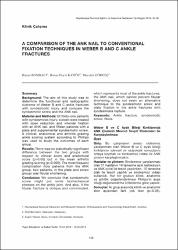| dc.contributor.author | Bombacı, Hasan | |
| dc.contributor.author | Katıöz, Hasan Feyzi | |
| dc.contributor.author | Görgeç, Mücahit | |
| dc.date.accessioned | 2021-12-12T16:51:17Z | |
| dc.date.available | 2021-12-12T16:51:17Z | |
| dc.date.issued | 2014 | |
| dc.identifier.issn | 1300-6363 | |
| dc.identifier.uri | https://app.trdizin.gov.tr/makale/TWpRd05qWXhNUT09 | |
| dc.identifier.uri | https://hdl.handle.net/20.500.11857/2522 | |
| dc.description.abstract | Giriş: Bu çalışmanın amacı sidesmoz yaralanması olan Weber B ve C ayak bileği kırıklarının işlevsel ve radyolojik sonuçlarını ortaya koymak ve sindesmoz vidası ile ANK çivisini karşılaştırmaktır.Hastalar ve yöntem: Sindesmoz yaralanması olan 31 hastanın 16 tanesine açık redüksiyon ve ANK çivisi ile tespit yapılırken, 15 tanesine plak ile tespit yapıldı ve sindesmoz vidası kullanıldı. Her bir grubun klinik, anatomik ve artritik değerlendirilmesi Philips'in ayak bileği değerlendirme kriterlerine göre yapıldı.Sonuçlar: İki grup arasında klinik ve anatomik skor açısından fark yok iken (p>0.05), ortalama artritik skor açısından fark mevcuttu (p<0.005). En sık komplikasyon (ANK grubunda dört hasta, plak-vida grubunda iki hasta) fibular kısalık idi.Çıkarımlar: Sonuç olarak sindesmoz vidası ayak bileğindeki biyomekanik stresi arttırabilir. Fibular kısalmayı önleyemeyen ANK çivisi, ayak bileği kırıklarının büyük bir çoğunluğunu oluşturan oblik ya da parçalı fibula kırıklarında, plak-vida uygulamasına alternatif bir tedavi yöntemi gibi durmamaktadır | en_US |
| dc.description.abstract | Background: The aim of this study was to determine the functional and radiographic outcome of Weber B and C ankle fractures with syndesmotic injury and compare the syndesmotic screw and the ANK nail.Material and Methods: Of thirty-one patients with syndesmosis injury, sixteen were treated with open reduction and internal fixation with an ANK nail, and fifteen patients with a plate and supplemental syndesmotic screw. A clinical, anatomical and arthritis grading ankle scoring system according to Phillips was used to study the outcomes of each group.Results: There was no statistically significant difference between the two groups with respect to clinical score and anatomical score (p>0.05) but in the mean arthritis grading scoring (p<0.005). The most frequent complication (four patients from the ANK group, two patients, in the plate and screw group) was fibular shortening.Conclusion: We conclude that syndesmotic screw might put some biomechanical stresses on the ankle joint. And also, if the fibular fracture is oblique and comminuted hich represents most of the ankle fractures, the ANK nail, which cannot prevent fibular shortening, does not seem an alternative technique to the syndesmotic screw and plate fixation in the ankle fractures with syndesmosis rupture. | en_US |
| dc.language.iso | tur | en_US |
| dc.relation.ispartof | Haydarpaşa Numune Eğitim ve Araştırma Hastanesi Tıp Dergisi | en_US |
| dc.rights | info:eu-repo/semantics/openAccess | en_US |
| dc.subject | Tıbbi Araştırmalar Deneysel | en_US |
| dc.subject | Ortopedi | en_US |
| dc.title | A COMPARISON OF THE ANK NAIL TO CONVENTIONAL FIXATION TECHNIQUES IN WEBER B AND C ANKLE FRACTURES | en_US |
| dc.title.alternative | Weber B ve C Ayak Bileği Kırıklarında ANK Çivisinin Mevcut Tespit Yöntemleri ile Karşılaştırılması | en_US |
| dc.type | article | |
| dc.department | [KLÜ] | |
| dc.identifier.volume | 54 | en_US |
| dc.identifier.startpage | 145 | en_US |
| dc.identifier.issue | 3 | en_US |
| dc.identifier.endpage | 155 | en_US |
| dc.relation.publicationcategory | Makale - Ulusal Hakemli Dergi - Kurum Öğretim Elemanı | en_US |



















